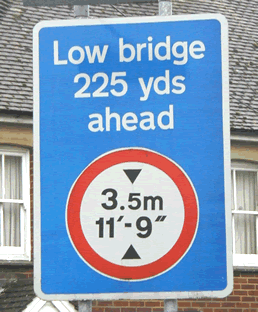If we could use one unit for distance, height, width, length etc on our roads?
The following sign:

displaying information in 4 different units (yd, ft, in, m) would be replaced, if we changed over to metric, with a sign like this:

with only one unit, the metre. Yet it contains exactly the same information.
Motorists have to take in a lot of information at one time (far too much according to a recent RAC report) from road signs and other sources.
The least we could do is make things easier wherever we can!

It also should be considered just how many drivers from the EU are driving on British roads at any given time. Not just the long haul truck drivers, but holiday makers and the many 1000’s of people who work here but keep their home country registered car here as well. They can drive anywhere in the EU, but it’s only Britain where there is a totally unknown system of height, weight and speed in use.
There is no reason for the metric changeover to take so long. Other countries such as Australia and New Zealand managed to complete their changeover in several years, yet in Britain it’s taking over 30, with no clear timetable in sight.
LikeLike
What really gets me is that both my current and my last car (both Vauxhalls) show my vehicle dimensions ONLY in metric units – the only place where non-metric units are used anywhere in the manuals are where maximum speed and fuel consumption are listed, all other measurements (vehicle weights, oil water and fuel capacities) are all metric.
However in many cases when I drive past a width or height restriction sign they are imperial units only. Having been metric educated in a metric country (yes, the UK!) and knowing my car size and weight in Metric I have to convert to feet and inches! If my car then gets damaged who do I blame?
It seems that the use of imperial-only signs is actually increasing at the moment; in my area I’ve seen several combined signs replaced with imperial-only and it seems that roadwork signs on motorways, particularly in the South East, are using imperial only more often these days!
LikeLike
The all metric is much easier to understand and comprehend, especially when driving, it makes sense to have it all consistent. I hope the UK government choose to make all road signs metric only as soon as possible. Ireland did so at the start of 2005 and it worked well, the UK can do so too. Nearly every driver on the roads has had some education in metric, so there should be no reason to delay a changeover any longer. We already have petrol in litres and fuel emissions in metric, lots of news reporting now uses metres and kilometres. It is not hard to use metric, but still the UK govt treats us like babies as if we were too dumb to use metric.
LikeLike
I’m fed up with all the inconsistencies in measurements such as these:
Petrol in pence per litre but consumption in miles per gallon
Emissions in grams per kilometre but road signs in miles
As far as consumption is concerned, I think litres per 100 km is a strange unit to use. Why not km per litre? After all, if the Imperial measurement – miles per gallon – is expressed in distance per volume, surely the metric unit should be as well?
With distance per volume (as in miles per gallon) a HIGHER value means higher economy, but with volume per distance (as in litres per 100 km) a LOWER value means higher economy! That’s something that it could be quite tricky to get used to!
LikeLike
IMHO, Litres per 100 km is the correct unit to use.
When we cost things we normally do so is cost per unit benefit. If we buy bananas, they are priced in pence per kilogram (or illegally in pence per pound by some market traders). In both cases, the cost is in pence and the benefit is in kilograms or pounds. The unit benefit is one kilogram or one pound.
In the case of motoring, the cost is in litres of fuel and the benefit is distance driven. The unit of benfit in this case is the benefit of having travelled 100Â km.
It is easy to convert the cost in litres of fuel to cost in money – if fuel is 90p/litre, then the cost of fuel consumed by a car that get 7 L/100 km will be £6.30/100 km.
LikeLike
When I lived in Canada, I quite quickly, as did most (though certainly not all – there are always hold-outs), got used to fuel economy in L/100 km. It’s just numbers after all, and once you know what the ‘yardsticks’ (sorry!) are, you simply know what’s good and what’s not. Thus 6 L/100 km is very good, 10 L/100 km not too bad for a largish car, but don’t expect much more than 15 L/100 km from your big SUV. That’s all there is to it, and it doesn’t matter whether you think the numbers should be higher or lower to denote a better or worse fuel economy.
LikeLike
I’m pleased your mock-up sign uses the proper Transport fonts. However, I’d prefer a triangular sign (as a low bridge is a type of hazard).
LikeLike